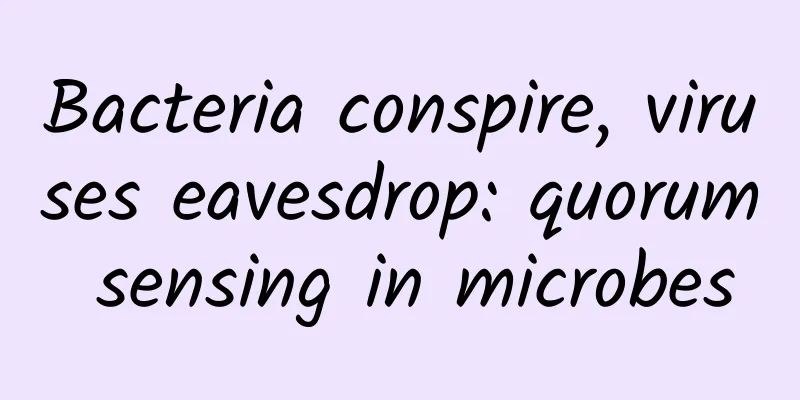Bacteria conspire, viruses eavesdrop: quorum sensing in microbes

|
A month ago, we reported that the 2022 Wolf Prize in Chemistry was awarded to Bonnie Bassler, a researcher in the field of cell communication. Professor Bassler studies the unique language system for communication between microorganisms. How was this system discovered and how was it cracked? What practical significance does it have for clinical medical applications? Today's article shows us the fascinating charm of this basic research. Written by Hong Wei (PhD in History of Science and Technology) The famous French social psychologist Le Bon said in The Crowd: The sum of the common characteristics inherited by all individuals of a race constitutes the soul of the race. However, when a certain number of individuals gather into a group to perform a certain action, observations show that due to their gathering together, some new psychological characteristics emerge, which overlap with the characteristics of the race and sometimes differ greatly from them. The emergence of human group behavior has always been a topic of concern to sociologists. However, group behavior is not unique to humans or higher animals. In recent years, microbiologists have discovered that bacteria also have their own unique group behaviors. Through a unique chemical language system, bacteria can communicate with each other, sense each other, and collectively vote to make decisions. Specifically, the physiological and biochemical characteristics of bacteria change with the density of the group, showing characteristics and group behaviors that a small number of bacteria or a single bacteria do not have, in order to respond to changes in the environment. This phenomenon is what microbiologists talk about with great relish, "quorum sensing." Bacteria are so small that they cannot be observed by the naked eye and they do not make any sound. Without the help of modern technology, we cannot directly observe their individual behaviors, let alone monitor their communication process and analyze their group behavior. To humans, all their actions before being discovered are like conspiracies, and scientific experiments are the researchers' explorations. Next, we will briefly review the discovery of quorum sensing and the process of cracking the microbial language system. one Glowing bacteria give away secrets In 1913, E. Newton Harvey, a young Princeton University teacher who loved hiking and collecting biological specimens since childhood, traveled around the South Pacific with aquatic biologist Alfred G. Mayer and stayed on Murray Island in Australia for three months. It was during these three months that Harvey gradually became fascinated by the phenomenon of bioluminescence. Three years later, Harvey and his newlywed wife, who was engaged in aquatic biology research, went to Japan for their honeymoon. On the west coast of Japan, he was attracted by the blue light on the sea. What fascinated him even more was that the light source sea firefly (Vargula hilgendorfii) is a marine invertebrate and a perfect research material. After being dried and stored for many years, its light-emitting system can be revitalized as long as it is moistened with water. No one knows how many dried sea fireflies Harvey transported back to the United States that time, but he has been using these materials for research in the following forty years. Harvey (E. Newton Harvey) 丨 Image source: Arizona State University, USA, Sea fireflies form a blue river on the coast of Okayama, Japan | Image source: Harvey's research fields are very broad, and bioluminescence is just one of them. By chance, he discovered that microorganisms can also glow. In 1953, Bernard L. Strehler first found the chemical molecule DPN (Disphosphopyridine nucleotide) that affects luminescence from the luminescent bacteria (Achromobacter fischeri, also known as Vibrio fischeri), and completely extracted the luminescence system from the bacteria to achieve extracellular luminescence. Upon hearing the good news, when Harvey discovered that Strehler's mentor was his favorite student William D. McElroy, he said proudly: "Now, I feel like I am the grandfather of research in the field of bioluminescence!" Interestingly, among Harvey's many students, J. Woodland Hatstings was both his disciple and his disciple's disciple. In 1948, Hastings studied for his doctorate with Harvey, and in 1951, he did postdoctoral research with McElroy. In Harvey's laboratory, Hastings developed a new technology to measure the quantitative oxygen requirements of the luminescence reactions of different species. In McElroy's laboratory, Hastings worked in the traditional field of firefly luminescence system for a period of time, and then turned to luminous bacteria. J. Woodland Hatstings | Image source: Harvard University At that time, the academic community generally believed that the behavior of bacteria was independent and did not depend on other individuals. According to this idea, if the number of bacteria doubled, the light intensity should also double at the same time. However, in 1970, Hastings noticed a strange phenomenon in Vibrio fischeri and Vibrio harveyi (named after Harvey in 1936). In the newly inoculated culture medium, the number of bacteria could double every 30 minutes, but the luminescence took more than 2 hours to begin to increase, and then the brightness doubled every 5 minutes. At the same time, the bacteria also continuously release a molecule called homoserine lactone (HSL) into the culture medium, and only when HSL reaches a certain concentration will the suppressed specific genes start the transcription program, and the bacteria can bloom with charming light. This is the first time that scientists have discovered the phenomenon of quorum sensing in recorded history. Hastings called the signal molecule HSL an "autoinducer (AI)" because, unlike external inducers, HSL can both induce gene expression and is produced by the bacteria themselves. For new things or new theories, the public always needs a slow process of acceptance, and sometimes even full of resistance. Like many people who have made major discoveries in history, Hastings was in a similar situation this time. Instead of accepting his discovery, the academic community ridiculed it. two The language system is broken Michael R. Silverman of the Agouron Institute is an exception. He thought Hastings's discovery was extremely interesting, and in the 1980s he found the core molecular mechanism of quorum sensing. In Vibrio fischeri, Silverman found that the LuxI protein catalyzed the synthesis of AI molecules, and the LuxR protein, as a receptor, bound AI and activated the transcription of the gene encoding luciferase. Next, he conducted an E. coli transformation experiment. The modified E. coli was able to produce the signal molecule HSL and use it to sense the concentration of bacteria. When the concentration of bacteria reached a threshold, E. coli began to emit light. Gradually, he found genes and proteins that can produce and detect extracellular signal molecules, and fully explained to the academic community how these components stimulate quorum sensing. Silverman rarely gave public speeches and had always existed in the scientific community like a "hermit". By chance, Bonnie Bassler, who was about to graduate with her doctorate, attended one of his lectures, which was about how bacteria activated the luminescence system through quorum sensing. Bassler felt that this was wonderful, that bacteria could actually vote on when to turn on the light! More importantly, she realized the convenience of luminous bacteria as materials for genetic research. As long as she pressed the light switch in the laboratory and saw whether the bacteria glowed, she could know the results of the experiment. As soon as the lecture ended, she ran straight to the podium and told Silverman that she wanted to be a postdoctoral fellow with him. Silverman was infected by her research passion and promised her a job on the spot. This dramatic beginning became the most talked-about scene in Bassler's various public speeches. After gaining a capable person, the generous Silverman completely handed over the research on quorum sensing to her and retired to the countryside again. Michael R. Silverman and Bonnie Bassler | Image source: Princeton University Department of Chemistry Twitter homepage It is worth noting that they found signal molecules and related genes and proteins, and roughly understood the operation process of the bacterial luminescence system, but they did not formally name this bacterial group phenomenon. In 1978, E. Peter Greenberg, a postdoctoral fellow of Hastings, began to independently lead an experimental team at Cornell University, also using Vibrio fischeri to do similar work. Biological research is time-consuming and labor-intensive, and the road is long and difficult. It was not until 1994 that this group behavior of luminous bacteria finally had a formal name during a brainstorming session of Greenberg's research team: "quorum sensing". This field was quite cutting-edge at the time, and in order to gain widespread attention from the academic community, the name had to be slightly distinctive. As expected, the name "quorum sensing" has gradually been widely accepted by the academic community, and more and more scientists have paid attention to and studied it, gradually forming a relatively large group. At present, there are hundreds of laboratories around the world engaged in related research. However, Basler, who arrived at the Agron Institute in 1990, did not focus on Vibrio fischeri, but turned to Vibrio harveyi. Basler found that when Vibrio harveyi communicates with its own bacteria, it also relies on an HSL autoinducer. The difference is that Vibrio harveyi also releases another chemical molecule to stimulate interspecies quorum sensing. In other words, Vibrio harveyi has two different quorum sensing systems. The first autoinducer is used for intraspecies communication, called AI-1; the second autoinducer is used for interspecies communication, called AI-2. It turns out that bacteria are not only not autistic, but more like language geniuses. Scientists then realized that the bacterial world may have multiple languages like humans. Later studies found that bacteria even have a universal language. Autoinducers include not only HSL, the common acyl-homoserine lactones (AHLs), but also other types: for example, Gram-positive bacteria generally use oligopeptide signal molecules (Autoinducing Peptide, AIP), Vibrio-specific cholera autoinducer (Cholera autoinducer 1, CAI-1), and interspecies communication signal molecules such as furanoyl boric acid diester (Autoinducer-2, AI-2), etc. The discovery of these signal molecules is the result of the hard work of many researchers and is the inevitable result of their exploration. Necessity often hides contingency, and sometimes even romance. For example, the crystal structure analysis of AI-2 is a bit legendary. At that time, Basler had just started to lead her own laboratory independently at Princeton University. Soon, she and crystallographer Fred Hughson jointly analyzed the crystal structure of AI-2 produced under experimental conditions. The analysis results shocked all the researchers present, because AI-2 molecules actually contain boron atoms, and the element "boron" is extremely rare in nature. What's even more incredible is that boron comes from glass test tubes. In order to improve the performance of glass, glass companies often mix some boron elements, and this trace amount of boron perfectly restores the living environment of Vibrio in nature. Imagine if they used plastic test tubes that did not contain boron, perhaps the secret of AI-2's molecular structure would not have been discovered so early! Interestingly, different bacteria will perform different chemical processes on AI-2, so AI-2 has become a universal language in the bacterial world. What's even more interesting is that some bacteria can use this universal language to deceive other populations. For example, Basler found that in a mixed bacterial population, E. coli would consume AI-2 of Vibrio cholerae, making them think that the population did not reach the threshold required for quorum sensing. The key to Vibrio cholerae's pathogenicity is that it activates quorum sensing to release toxins, which in turn causes diarrhea in the host. When Vibrio cholerae finds that it has not reached the number required for quorum sensing, it takes the opportunity to slip out of the host and look for the next victim. In this way, E. coli in the intestines may be able to prevent Vibrio cholerae infection and further spread by interfering with quorum sensing. Bonnie Bassler and her luminous bacteria | Image source: American Public Broadcasting Corporation, After decades of research, scientists now know that quorum sensing can turn on or off the expression of hundreds of genes in bacteria. In other words, the communication process of bacteria initiates a huge genetic program. This process is similar to embryonic development, which enables bacteria to quickly complete the transformation from individual members to group members. Quorum sensing also regulates many other behaviors of bacteria, such as biofilm formation, production of pathogenic factors, synthesis of antibiotics, conjugation transfer of plasmids, and bacterial migration and movement. Some of these behaviors are related to the pathogenic mechanism of bacteria. Greenberg mentioned above is a leader in this field. Since he independently led the research team, he has studied not only Vibrio fischeri but also spirochetes, and has made great achievements and influence in the latter field. In 1988, after returning to his alma mater, the University of Iowa, Greenberg began to focus on the study of LuxR protein in Vibrio fischeri. Greenberg (E. Peter Greenberg) | Image source: University of Washington At that time, Silverman had already found out that LuxR protein is a transcription factor activated by autoinducers, which in turn binds to autoinducers and participates in quorum sensing of cells. Later, the team led by Greenberg discovered that the C-terminus of LuxR protein is conserved and the N-terminus is variable. 30% of the sequences at the C-terminus retain the ability to activate luminescent genes, but do not require signal molecules. The 60% of sequences closest to the N-terminus can bind to signal molecules but cannot affect gene transcription. In other words, they further figured out the molecular mechanism of LuxR protein's participation in quorum sensing, which is one step closer to completely cracking the bacterial language system. Greenberg decisively stopped the relevant research on spirochetes and went all out to conduct research on the "signal" of quorum sensing. During a meeting, he accidentally learned that Barbara Iglewski's laboratory at the University of Rochester had found the regulatory genes of the pathogenic factor of Pseudomonas aeruginosa (also known as Pseudomonas aeruginosa), one of which had a gene sequence that was highly homologous to the LuxR gene, indicating that quorum sensing may be closely related to the production of pathogenic factors. After a period of communication, he and Iglewski hit it off and immediately decided to cooperate, focusing on the study of quorum sensing of Pseudomonas aeruginosa. As the research deepened, they found that quorum sensing controls many important genes related to pathogenic factors. It is worth mentioning that Pseudomonas aeruginosa is widely present, and there are traces of it in the skin, respiratory tract and intestines of normal people. However, it is also a conditional pathogen and one of the main pathogens of hospital-acquired infections. At the same time, it is also a deadly killer of patients with cystic fibrosis (CF). CF is an autosomal recessive disease that is highly prevalent in Caucasians, with about 35,000 people in the United States suffering from it. The patient's mucus is too viscous, and it is difficult for the lungs to expel bacteria, making infection relatively easy to occur. If Pseudomonas aeruginosa produces virulence proteins when the cell concentration is low, it is undoubtedly reminding the host to start an immune response as soon as possible. However, Pseudomonas aeruginosa is very smart. They only turn on quorum sensing when their own cell concentration is quite high, produce toxic proteins, destroy lung tissue, and achieve the purpose of seriously damaging lung function. During the treatment process, CF patients need to use antibiotics continuously. However, Pseudomonas aeruginosa is naturally resistant to most antibiotics and can quickly produce drug-resistant mutations, which is really worse! Over the years, CF patients are finally trapped in the quagmire of no cure, allowing the disease to torture them until they die. If one day an inhibitor of quorum sensing can be developed, CF patients may be able to get relief. Hastings once said in an interview: "Compared to a very practical research field like cancer, bioluminescence or circadian rhythm is a very basic research, and researchers must have a genuine love for it." What he didn't expect was that it was because of the research on bioluminescence that scientists gradually developed his "quorum sensing" and now have unknowingly introduced basic research into practice. three Viruses are eavesdropping In recent years, researchers have begun to work with drug development companies to try to develop quorum sensing inhibitors, hoping to bring new technologies to fight diseases, so that patients will no longer be troubled by bacterial resistance and enter the "post-antibiotic era" as soon as possible. The headache is that many cunning bacteria are very patient. They know that on their own, a single bacterium will be easily cleared and eliminated by the host. So they quietly replicate, divide, and mutate, waiting for the right time until they think the group has reached a certain size, then they will initiate collective action, work together, and attack the host. It can be seen that they are by no means a "mob." For this reason, scientists and pharmaceutical companies have not yet developed a viable drug to deal with the "quorum sensing" of bacteria and break through the bacterial fortress. Schematic diagram of quorum sensing | Image from Twitter Even such an elite group has its natural enemies. There are other species in the world that have cracked their secrets faster than humans, that is, bacteriophages - a virus that attacks bacteria. One day, Justin Silpe, a graduate student of Basler, proposed a bold idea that viruses would eavesdrop on bacterial communication. Although Basler was skeptical, he still let him explore freely. Silpe used a bacteriophage called VP882 to infect Salmonella. He observed that the bacteriophage would extract the host's molecular signals, but did not participate in the bacterial communication, but used it to decide when to attack the bacteria. When the signal became stronger and stronger, the virus knew that the bacterial population was large enough, and it was time to produce offspring and lyse the host! The released new bacteriophages would then infect other bacteria, annihilating the bacterial army. Just one year before Silpe published his research results, a laboratory at the Weizmann Institute of Science in Israel confirmed that there is also a communication system in viruses. Rotem Sorek and his team originally wanted to use bacteriophages to infect bacteria and then observe whether the bacteria would fight back against the phages alone or in groups, but they made an unexpected discovery. The bacteria were very quiet, and the viruses were noisy. It turned out that the viruses were transmitting information in their own language. The phages knew when to lurk in the host cells and when to attack. As the research went further, Sorek discovered that the signal molecule used by the phages was an oligopeptide, and named this molecule "arbitrium." Through the study of viruses, scientists have gained a better understanding of the quorum sensing system of microorganisms, and found a new breakthrough in dealing with microbial infections. However, we must not forget that microorganisms are everywhere and have existed on Earth for billions of years. Although scientists have a beautiful vision, the road ahead is long and arduous! Thanks to Professor Jing Yan of Yale University for his professional guidance and patient review! Main references [1] Gustave Le Bon, The Crowd: The Psychology of Groups, translated by Dong Qiang, Zhejiang Literature and Art Publishing House, 2018. [2] Frank H. Johnson, Edmund Newton Harvey (1887-1959), National Academy of Sciences, 1967. [3] L. Stephen Coles, Bernard Strehler (university of Southern California, Professor of Biology), Journal of Anti-aging Medicine, Volume 4, Number 3, 2001, p: 233-234. [4] Tinsley H. Davis, Profile of J. Woodland Hastings, Proceedings of the National Academy of Sciences Jan 2007, 104 (3) 693-695. [5] Farooq Ahmed, Profile of Bonnie L. Bassler, Proceedings of the National Academy of Sciences Apr 2008, 105 (13) 4969-4971. [6] Tinsley H. Davis, Biography of EP Greenberg, Proceedings of the National Academy of Sciences Nov 2004, 101 (45) 15830-15832. [7] U.S. Centers for Disease Control and Prevention website on cystic fibrosis. [8] Bernard L. Strehler, Milton J. Cormier, Factors Affecting the Luminescence of Cell-Free Extracts of the Luminous Bacterium, Achromobacter fischeri, Archives of Biochemistry and Biophysics, 1953: p16-33. [9] Susan Brink, A Virus Can Eavesdrop On Bacterial Communication, December 13, 2018. https://www.npr.org/sections/goatsandsoda/2018/12/13/676389858/a-virus-can-eavesdrop-on-bacterial-communication [10] Elie Dolgin, The Secret Social Lives of Viruses, Nature, 18 June 2019. Special Tips 1. Go to the "Featured Column" at the bottom of the menu of the "Fanpu" WeChat public account to read a series of popular science articles on different topics. 2. Fanpu provides a function to search articles by month. Follow the official account and reply with the four-digit year + month, such as "1903", to get the article index for March 2019, and so on. Copyright statement: Personal forwarding is welcome. Any form of media or organization is not allowed to reprint or excerpt without authorization. For reprint authorization, please contact the backstage of the "Fanpu" WeChat public account. |
>>: The "alkaline water myth" is back? Experts have only three words to say: unscientific!
Recommend
What car can be sucked on the top of the tunnel and speed? You have to learn aerodynamics!
Recently, a kid sent me a video: a sports car ent...
Ice does not conduct electricity? Did you notice the physics knowledge in Nezha 2?
Review expert: Zhou Hongzhi, senior laboratory te...
Improve the quality of the game with details, and build a mountain village with dignity
[[151804]] We often say that details determine su...
Can't buy vitamin C? Don't panic, these foods are very good for vitamin C!
With the relaxation of new epidemic prevention po...
The perfect tracker that took half a year to design was dismantled by the Bully Bird in ten minutes
This bird has become a spirit! In Australia, scie...
A detailed lecture on "Oxford Doctor's Paper Airplane Physics Class"
Resource introduction of the Oxford Doctor's ...
“Heating food in a microwave oven can produce carcinogens”, is this true?
As a small household appliance that almost every ...
Qualcomm Snapdragon can run Win10. What does Microsoft want to do?
The yellow bell is broken and discarded, while the...
iOS14 is coming soon. Lao Tang talks about the development history of iOS versions
In 2007, 10 years after returning to Apple, Steve...
Planning introduction: numerical design starts from these three aspects
[[150172]] Numerical design is actually born for ...
The inside story of Android market promotion channels and tips on how to avoid pitfalls!
What I want to share with you today is the Androi...
Huawei HMS will cooperate with India's Indus OS to replace Google GMS with 400,000 APP applications
According to cnbeta, Huawei will cooperate with I...
The online marketing plan for Women’s Day is here!
along with With the rise of “her economy”, Women’...
Taoist Yin Pan Qimen Dunjia Zhengfan Hall 35 episodes video
Taoist Yin Pan Qi Men Dun Jia Zheng Fan Tang 35 e...
Fifty-three years of dream fulfilled: Mr. Qian Xuesen and the earliest Chinese space station concept
Produced by: Science Popularization China Produce...









